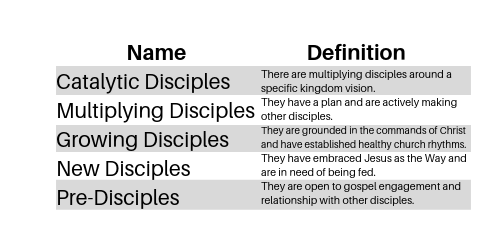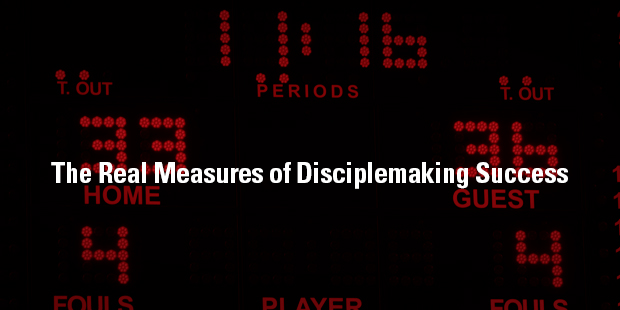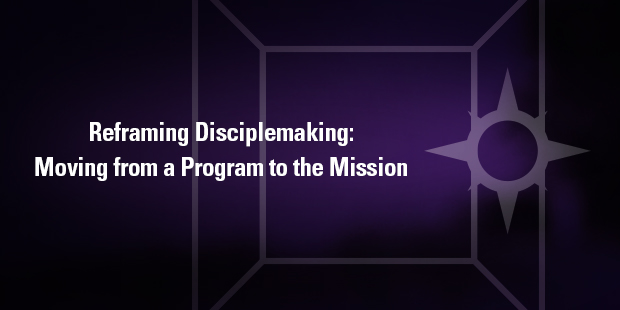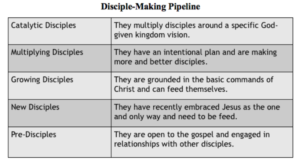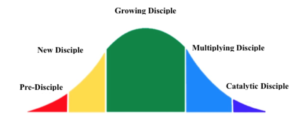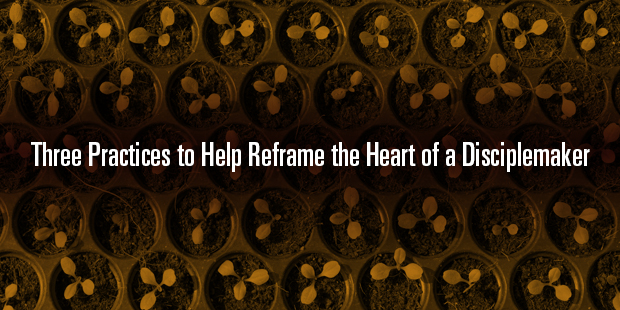
The Disciplemaking Worldview: What is the Church?
Auxano Navigator David Putman is committed to catalyzing gospel-centered, disciple-making movements. He lives out his mission by helping others go further, faster, and longer than they ever imagined. David’s writings have been the primary foundation of this SUMS Remix.
According to David, disciple making at its core is about worldview transformation. A person’s worldview is the way they see and understand the world. Our worldview is based on our core beliefs. These non-negotiable beliefs determine our behavior. In other words, what we believe determines our behavior.
As a disciple of Christ we might frame it this way, “What we believe about the gospel determines how we follow Jesus.”
David uses a simple tool he created called the “Gospel Lens” to illustrate this. This tool is based on three questions that he believes have a very unique and specific relationship to one another.
It is essential that we begin with the gospel, move to disciple, and finally to the church in the order we ask and answer these questions. In other words, the gospel informs our understanding of disciples, and our understanding of disciples informs our understanding of the church.
THE QUICK SUMMARY – Church 3.0 Upgrades for the Future of the Church by Neil Cole
An expert practitioner answers questions about the burgeoning organic church movement.
Neil Cole’s best-selling book Organic Church described the fastest growing segment of contemporary Christianity-the so-called organic church. Now in this next-step book, he answers questions about how to deal with theological and organizational issues that come up. He talks about issues such as what to do with finances, children, heresy, leader training, rituals and ordinances. Without the top-down structure of a denomination, even people who are proponents of this small, house-church model worry that they are not doing it right.
- Offers an important resource for anyone involved with or thinking of starting an organic or house church
- Addresses practical issues of theology, rituals, doctrinal heresy, how to handle children, finances, and other important questions
- Written by an acknowledged expert who is now and has been for over twenty years an organic church planter and practitioner
- A new Leadership Network title and follow-up to Organic Church
Church 3.0 offers solid information about organic churches based on Cole’s extensive experience in starting, nurturing, and mentoring in the organic church movement.
A SIMPLE SOLUTION
In Christ we are redeemed, renewed, and ultimately all things are restored. Once again Jesus uses the power of a simple parable to convey this pregnant truth. “He told them another parable: ‘the kingdom of heaven is like a mustard seed, which a man took and planted in his field. Though it is the smallest of all your seeds, yet when it grows, it is the largest of garden plants and becomes a tree, so that the birds of the air come and perch in its branches’” (Matthew 13:31-32, NIV). In this parable we see the impact of the gospel to restore all things. A mustard seed grows, becomes the larges of garden plants, even becomes a tree, and the birds of creation come and find rest in them. What God began He completes in Jesus.
If you flip over and read the last chapters of Revelation you see this playing out. John “saw a new Jerusalem, coming down out of heaven from God” (Revelations 21:2, NIV). In this picture we aren’t going up, but heaven is coming down in keeping with Jesus’ message of the kingdom of heaven is here or at hand. God is doing a work in His world. He isn’t done. He is restoring all things. What He began in one garden He concludes in another garden.
Now God is working through His church to restore all things. As Paul declares, “We are therefore Christ’s ambassadors, as though God were making his very appeal through us” (I Corinthians 5: 20, NIV). Jesus tells us we “are the salt of the earth and light of the world” (Matthew 5:13 &14, NIV). Salt and light have their greatest impact from within. As restorers we enter into God’s redemptive, renewal, and restorative work. As restorers we enter into the lives of those who are in the most need of redemption, renewal, and restoration. We become God’s ambassadors. The gospel restores us that we might be restorers.
This changes everything. People are not to be seen as a means to an end. People are the end.
When people encounter Jesus, alive and present as King, they get a taste of God’s Kingdom on earth as it is in heaven.
I have come to understand the church as this: the presence of Jesus among His people called out as a spiritual family to pursue His mission on this planet. Granted, this is quite broad, but I like a broad definition of church. The Scriptures don’t give a precise definition, so I’m not going to do what God has not done. I want something that captures what the Scriptures say about the body of Christ. In one of only two places where Jesus mentions church in the Gospels, He says, “For where two or three have gathered together in my name, there I am in their midst” (Matthew 18:20). His presence then must be an important element of church.
In most of the definitions of church found in theological treatises a list of necessary ingredients is given including things such as qualified elders, regular meetings of believers, practice of the ordinances, and a doctrinal foundation. A noticeable absence is the inclusion of Jesus on the lists. If Jesus is missing in our understanding of church, He will likely be missing in our expression of church as well. Therein lies a huge problem in our churches. We have defined church by what we are and do, rather than by Jesus’ presence at work among us.
It dawned on me one day that the Bible never commands us to plant a church. When the disciples were sent out, they were to bring the Kingdom (or reign) of God to the places where people lived life. When Paul and Barnabas went out, they didn’t think of their task as starting churches but instead making new disciples. Our command is to connect people to Jesus as their King. We are to extend the reign of Christ on earth. The byproduct of this work is church.
Church is not meant to be the agent of change; Jesus is. The Bible doesn’t say, “For God so loved the world that He sent his only begotten Church.” Church is the result of the Gospel, not the cause. In a sense we are confusing the fruit with the seed. We must plant the seed of the Gospel of the Kingdom, and the fruit will be the changed lives living out their faith together, which is church.
The core importance of God’s church is not how the followers are organized, discipled, or helped. The core reality of God’s church is Jesus Christ being followed, loved, and obeyed. All else is consequence rather than cause. It all starts with a relationship with Jesus, and since Jesus is on mission to seek and save the lost so are his followers.
Neil Cole, Church 3.0 Upgrades for the Future of the Church
A NEXT STEP
Will Mancini believes that if your staff and volunteers don’t know your church’s disciple-making strategy, they invent their own.
Many times, this is not the fault of the volunteers but a failure on the part of senior leadership. Will adapts an article from Harvard Business Review entitled, “How Hierarchy can Hurt Strategy Execution” into some thoughts reframed for ministry. While the interrelated challenges of these obstacles make it hard to put in a ranking, he has attempted to do so in terms of linear progression. Also, there are many ways to define strategy. The one in use is “the process of a picture that shows how you accomplish the mission on the broadest level.”
Gather your senior leadership team together, distribute the following list, and discuss how each is evident (or not) at your church.
#1 Too focused on short-term results and tactics. Sunday’s a ‘comin. Enough said.
#2 Not taking time to develop a clear, coherent strategy. Because of the crowd fixation on the weekend worship event, most leadership teams never slow down enough to have the strategic conversation. This ultimately hinders forward progress in disciple-making and subversively reinforces a shadow mission, “to get as many people through the doors on Sunday.”
#3 Poor communication of strategy. If you do have a strategy, you can’t communicate it too much. The litmus test is getting the top 25 people in your leadership together and asking them to draw a picture that shows how you accomplish the mission. If they are not drawing the same picture, you’re not communicating enough.
#4 Lack of meaning for the front-line volunteers and their roles. Once it’s clear and being communicated, it must be translated to the front line. It can’t live only in the world of “thinkers,” but must be grasped, and joyfully so, by the “doers.”
#5 Departmental silos and ministry segments with competing agendas. One of the greatest barriers is not individuals but the momentum of church systems stuff from org charts, to decision-making structures. In church, the strategy first splinters to become meaningless in the children, student and worship “departments” which typically focus 100% of their attention on their unique short-term needs.
#6 Inconsistent or indecisive actions from senior leaders with regarding strategy. Once you set the course, you must lead the way. Strategy will set priorities and your people will quickly notice, from small daily actions, when the two disconnect.
#7 No follow-through on strategy with measurement, accountability, or celebration. Strategy won’t become meaningful without it becoming a cultural reality- something that shapes new thoughts, attitudes, and behaviors.
#8 Resistance to change. Leading with a strategy will always require some change. Some people will catch it painfully slow, and others will never see the light.
After your discussion time, celebrate where you have overcome these challenges. For those areas where you still struggle, brainstorm specific actions you will undertake to improve them.
Excerpt taken from SUMS Remix 108-3, released December 2018.
This is part of a weekly series posting excerpts from one of the most innovative content sources in the church world: SUMS Remix book excerpts for church leaders.
SUMS Remix takes a practical problem in the church and looks at it with three solutions; each solution is taken from a different book. Additionally, a practical action step is included with each solution.
As a church leader you get to scan relevant books based on practical tools and solutions to real ministry problems, not just by the cover of the book. Each post will have the edition number which shows the year and what number it is in the overall sequence. (SUMS Remix provides 26 issues per year, delivered every other week to your inbox).
>> Subscribe to SUMS Remix <<

Tags: Church 3.0, Disciplemaking, Neil Cole, SUMS Remix














